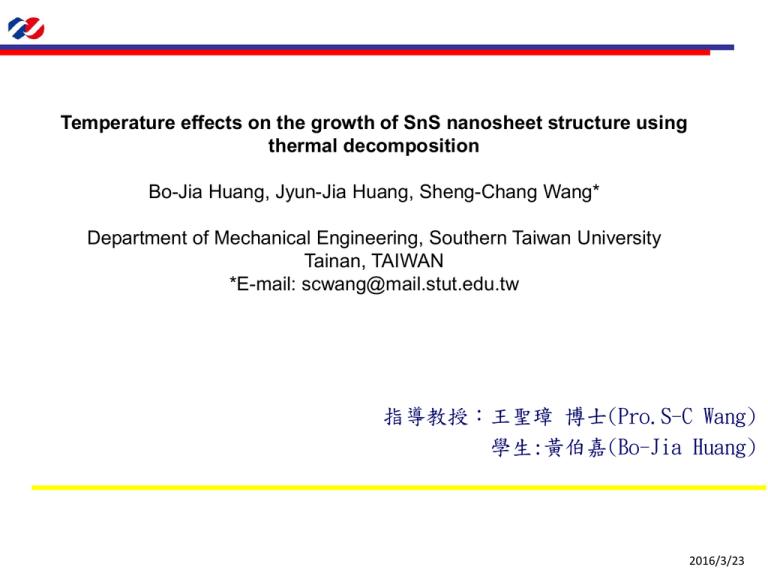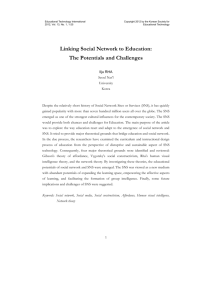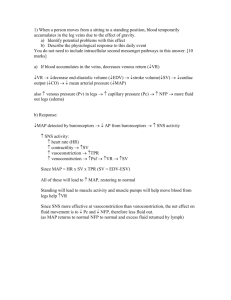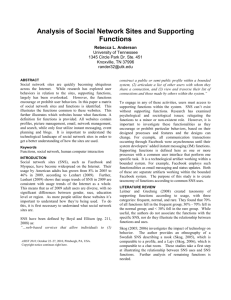Results and Discussion
advertisement

Temperature effects on the growth of SnS nanosheet structure using thermal decomposition Bo-Jia Huang, Jyun-Jia Huang, Sheng-Chang Wang* Department of Mechanical Engineering, Southern Taiwan University Tainan, TAIWAN *E-mail: scwang@mail.stut.edu.tw 指導教授:王聖璋 博士(Pro.S-C Wang) 學生:黃伯嘉(Bo-Jia Huang) 2016/3/23 Outline -Abstract -Introduction -Experimental -Results and Discussion -Conclusion 2 Abstract Abstract In this research, Tin sulfide (SnS) nanostructure were synthesized in oleylamine solution using thermal decomposition method. The sulfur and tin oleate were used as the S and Sn sources, respectively. Various decomposition temperature, were conducted to growth the SnS powders in Ar for 10-60 min. The morphology, electrical and optical properties of SnS film was characterized by SEM,TEM, XRD and UV-Vis. 4 Introduction Introduction SnS is a narrow band gap IV-VI semiconductor, which are optically active in the near-infrared and infrared. SnS band gad between that of Si (1.12 eV) and GaAs (1.43 eV) [1]. It has a high absorption coefficient (α>104 cm−1),and has absorbs the solar spectrum best to be able the crack value (~1.3 eV) [2].The theory electro-optic transfer efficiency can reaches as high as above 25%[3] In the past decades, these semiconductor attract great interest for their application in photovoltaics, near-infrared detectors and biomedical application. 6 Experimental Experimental In this study, chemical oleic acid, (OA , 90%, SHOWA, Japan), and commercial SnO powder (Riedel-de Haen, Germany) were used to form the tin oleate complex, and S powder dissolve in Oleylamine (OLA , 90%, ACROS), were used as the coordinating solvent and a phase transformation controller reagent. The detail synthesis procedure and characterization were shown in Fig. 1. SnO 1 mmol OA 3 mmol Heat to 310°C for 60 min and stir in Argon S 0.07 g OLA 6-18 ml Sn(OA)X 0.08 g Heat to 220~310˚C for 10~60 min and stir in Argon 5 ml Hexane and 15 ml ethanol centrifugation 5000 rpm with 30 min 5 ml Hexane and 15 ml ethanol contrifugation 5000 rpm with 30 min drying 100˚C with 20 min drying 100°C with 20 min Sn(OA)2 SnS SEM TEM fig1. Flow chart of experimental procedure. XRD 8 Results and Discussion Results and Discussion X-ray diffraction patterns obtained for SnS powder synthesized at different deposition potential are shown in Fig .2 a-b. All peaks in Fig.2a-b can be indexed to these of the orthorhombic SnS.the relative intensity of the peaks corresponding to the strongest peak(040)planes to that of (111) planes varies significantly from the reported values. Fig. 2 XRD patterns of SnS powder at various potentials : (a)at 220°C (b)at 280°C Results and Discussion The morphology of the SnS powder synthesized at 280°C was studied by SEM and TEM, which are shown in Fig. 3 (a) and (b). The shape of the SnS sample is flower-like composed by several sheet structures, which is observed by TEM image. The diffraction pattern of the irregular sheet structure is confirmed as the single crystal SnS phase, as shown in fig. 3 (c). Fig 3 Decomposition temperature at 220°C SnS crystal structure image. (a) SnS SEM (b)SnS TEM (c) SAED pattern Results and Discussion As the synthesis temperature increase to 280°C, the SnS morphology is changed to regular square sheet, as shown in SEM image of Fig. 4(a). The TEM image is further confirmed that the morphology of SnS is a squared sheet with rounded-corner. The TEM image shows uniformed contrast with some bending contour fringes in the nanosheet, which identify the sheet is 1 min edge length with very thin and uniform in thickness. Compared the TEM image and it corresponding diffraction pattern, we can conclude the that the edge direction of the nanosheet is <101> and the sheet plane is (010). Fig 4 Decomposition temperature at 280°C SnS crystal structure image. (a)SnS SEM (b)SnS TEM (c) SAED pattern Results and Discussion The representative optical absorption spectrum of the two kinds of SnS structures is shown in Fig. 5. This figure indicated that the both SnS structures have high absorption in the range of ultraviolet. The nanosheet SnS structure has a higher absorption than the flower-like SnS. Fig 5 SnS film on ITO glass absorption spectrum(A) flower like (B) sheet structure Conclusion Conclusion The two-dimensional SnS crystal were synthesized by hydrothermal decomposition using Sn(OA)2 and S powder as sources in OLA solovent. The results show that a flower-like SnS structure composed of several irregular flakes is synthesized at 220°C. A squared SnS nanosheet with rounded-corner structure is synthesize by 280°C. The nanosheet SnS structure has a higher absorption than the flower-like SnS 15 Thanks for your attention









